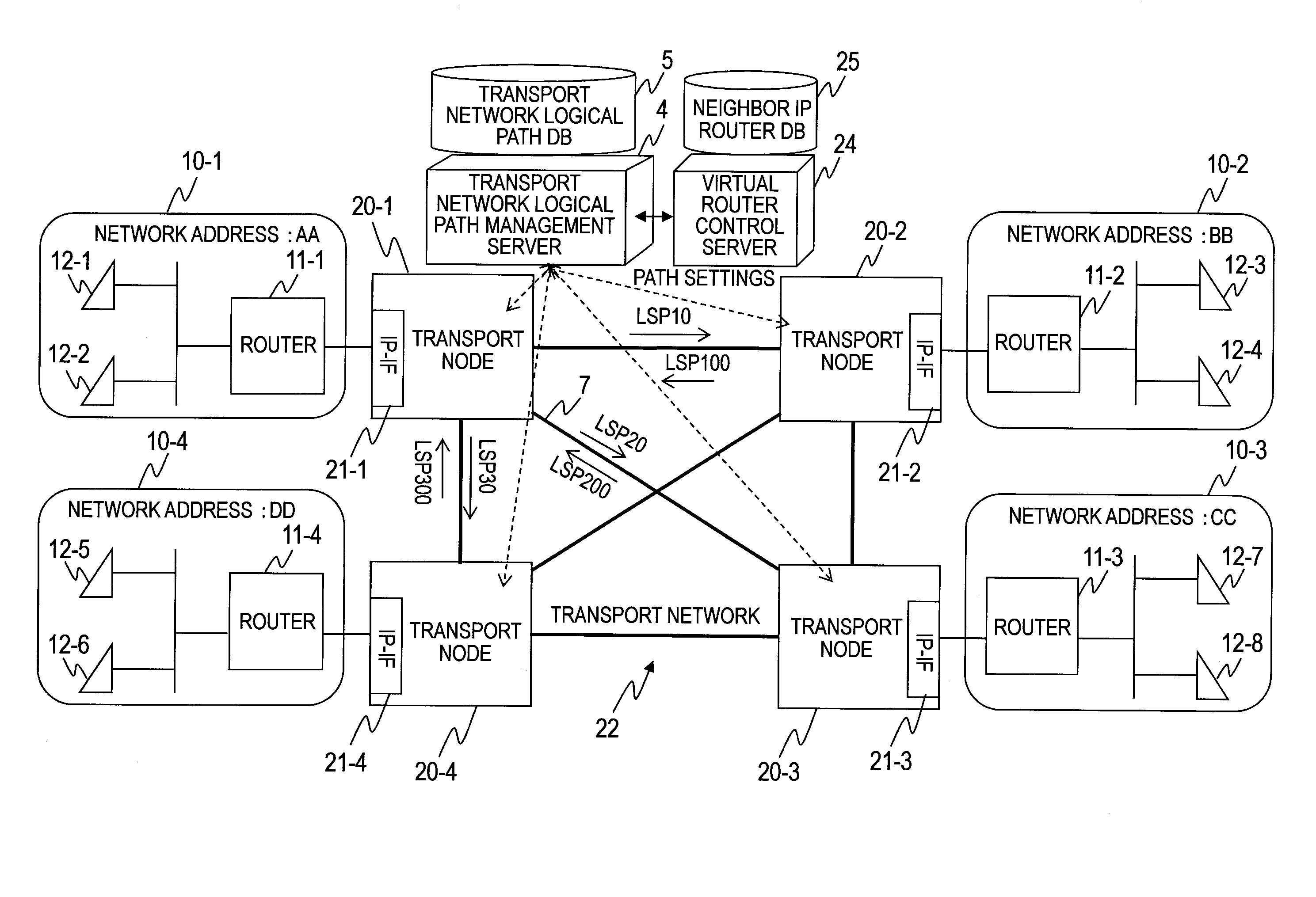Data Transport System and Control Method of Data Transport System
- Summary
- Abstract
- Description
- Claims
- Application Information
AI Technical Summary
Benefits of technology
Problems solved by technology
Method used
Image
Examples
first embodiment
[0046]FIG. 1 is a diagram illustrating an example in which routers owned by a transport network user are connected to a data transport system according to a first embodiment of this invention.
[0047]In the data transport system of FIG. 1, a telecommunication carrier provides a transport network 22 and the transport network user rents logical paths 7 of the transport network 22 from the telecommunication carrier. Four sites of the transport network user which are geographically distant from one another and which are denoted by 10-1 to 10-4 (bases 10-1 to 10-n, n is 4 in FIG. 1) are connected to one another via the transport network 22 of the telecommunication carrier.
[0048]The bases 10-1 to 10-n of the transport network user include routers (communication devices) 11 (11-1 to 11-n), which connect to the transport nodes 20 (20-1 to 20-n), and include communication terminals 12 (12-1 to 12-m). The communication terminals 12-1 to 12-m are, for example, routers, personal computers, or sim...
second embodiment
[0185]A second embodiment of this invention is described below with reference to the drawings. The difference in configuration of the second embodiment from the first embodiment is what contents are held in an entry of the routing information table 45 of the IP-IF card 21 which is provided in each of the transport nodes 20-1 to 20-n.
[0186]Settings of logical paths in the transport network 22 according to the second embodiment are described first with reference to FIGS. 1 and 16.
[0187]Logical paths set in the transport network 22 to and from the transport node 20-1 are the transmission LSP 10 and the reception LSP 100, which are formed with the transport node 20-2, the transmission LSP 20 and the reception LSP 200, which are formed with the transport node 20-3, and the transmission LSP 30 and the reception LSP 300, which are formed with the transport node 20-4.
[0188]FIG. 16 is a diagram illustrating an example of the contents of an entry in the routing information table 45 of the tr...
third embodiment
[0208]A third embodiment of this invention is described below with reference to the drawings. The difference in configuration of the third embodiment from the first embodiment is that routers have IP-IF cards and that the IP-IF cards of the routers are included as subjects of monitoring by a transport network logical path management server and a virtual router control server.
[0209]A connection configuration of the data transport system and a configuration of routers according to the third embodiment are described with reference to FIGS. 18 and 19.
[0210]FIG. 18 is a diagram illustrating physical connections of the data transport system according to the third embodiment. In the data transport system according to the third embodiment, a telecommunication carrier provides a transport network 122 and a transport network user rents logical paths 7 of the transport network 122 from the telecommunication carrier. Four sites which are geographically distant from one another and which are den...
PUM
 Login to View More
Login to View More Abstract
Description
Claims
Application Information
 Login to View More
Login to View More - R&D
- Intellectual Property
- Life Sciences
- Materials
- Tech Scout
- Unparalleled Data Quality
- Higher Quality Content
- 60% Fewer Hallucinations
Browse by: Latest US Patents, China's latest patents, Technical Efficacy Thesaurus, Application Domain, Technology Topic, Popular Technical Reports.
© 2025 PatSnap. All rights reserved.Legal|Privacy policy|Modern Slavery Act Transparency Statement|Sitemap|About US| Contact US: help@patsnap.com



